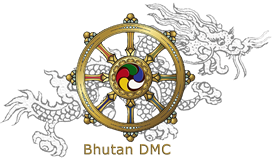Tshechu (or the religious festival) in Bhutan
Tshechu is a religious festival that begins on the 10th day of the Bhutanese calendar. During the festival, monks and laymen perform mask dances over a stretch of three to five days in a dzong (fortress / monastery), temple or monastery. The mask dances are showcased to commemorate the life of Guru Padmasambhava and other great Buddhist masters.
Tshechus customarily conclude with the unfurling of a Thongdrel (large scroll painting) of Lord Buddha, Guru Rinpoche, Zhabdrung and other enlightened beings. Tshechu festivals are grand events where entire communities come together to witness religious mask dances, folk dances, receive blessings and socialize. Besides the religious dances and songs, Atsaras are a major attraction during the Tshechu. Atsaras usually don hilarious looking masks with large protruding noses and often with a phallus dangling from the head. They signify enlightened wisdom, and their acts are intended to cleanse the collective sin of the people gathered to witness the religious dances.
The festival is also an occasion for people to wear their best finery, socialize and make merry. More importantly, local people attend Tshechus to gain merit.
HOTELS IN THIMPHU
HOTELS IN PUNAKHA & WANGDUE
HOTELS IN GANGTEY
HOTELS IN TRONGSA
HOTELS IN BUMTHANG
HOTELS IN MONGAR
HOTELS IN TRASHIGANG
HOTELS IN SAMDRUP JONGKHAR
HOTELS IN PHUENTSHOLING
HOTELS IN HAA
HOTELS IN GELEPHU
HOTELS IN ZHEMGANG
RESTAURANTS IN PARO
RESTAURANTS IN THIMPHU
RESTAURANTS IN PUNAKHA
TOUR ITINERARIES
TREKKING ITINERARIES
SPECIAL INTERESTS TOURS
UNIQUE FESTIVALS & FAIRS
BLOG


